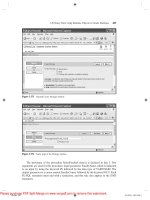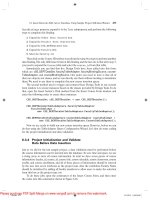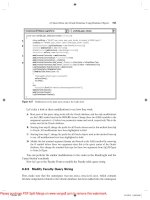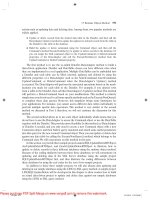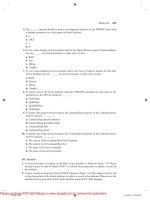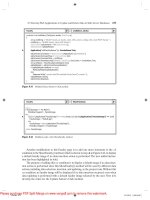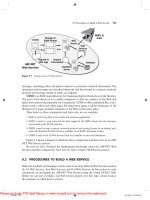Tài liệu Practical Database Programming With Visual C#.NET- P1 doc
Bạn đang xem bản rút gọn của tài liệu. Xem và tải ngay bản đầy đủ của tài liệu tại đây (532.91 KB, 50 trang )
Please purchase PDF Split-Merge on www.verypdf.com to remove this watermark.
babout.indd 904babout.indd 904 2/11/2010 11:47:38 AM2/11/2010 11:47:38 AM
Please purchase PDF Split-Merge on www.verypdf.com to remove this watermark.
Practical Database
Programming With Visual
C#.NET
ffirs01.indd iffirs01.indd i 2/11/2010 12:02:41 PM2/11/2010 12:02:41 PM
Please purchase PDF Split-Merge on www.verypdf.com to remove this watermark.
IEEE Press
445 Hoes Lane
Piscataway, NJ 08854
IEEE Press Editorial Board
Lajos Hanzo, Editor in Chief
R. Abari T. Chen B. M. Hammerli
J. Anderson T. G. Croda O. Malik
S. Basu M. El - Hawary S. Nahavandi
A. Chatterjee S. Farshchi W. Reeve
Kenneth Moore, Director of IEEE Book and Information Services (BIS)
ffirs01.indd iiffirs01.indd ii 2/11/2010 12:02:41 PM2/11/2010 12:02:41 PM
Please purchase PDF Split-Merge on www.verypdf.com to remove this watermark.
Practical Database
Programming With Visual
C#.NET
Ying Bai
Department of Computer Science and Engineering
Johnson C. Smith University
Charlotte, North Carolina
IEEE PRESS
A John Wiley & Sons, Inc., Publication
ffirs01.indd iiiffirs01.indd iii 2/11/2010 12:02:41 PM2/11/2010 12:02:41 PM
Please purchase PDF Split-Merge on www.verypdf.com to remove this watermark.
Copyright © 2010 by the Institute of Electrical and Electronics Engineers, Inc.
Published by John Wiley & Sons, Inc., Hoboken, New Jersey. All rights reserved.
Published simultaneously in Canada
No part of this publication may be reproduced, stored in a retrieval system, or transmitted in any form or by
any means, electronic, mechanical, photocopying, recording, scanning, or otherwise, except as permitted under
Section 107 or 108 of the 1976 United States Copyright Act, without either the prior written permission of
the Publisher, or authorization through payment of the appropriate per-copy fee to the Copyright Clearance
Center, Inc., 222 Rosewood Drive, Danvers, MA 01923, (978) 750-8400, fax (978) 750-4470, or on the web at
www.copyright.com. Requests to the Publisher for permission should be addressed to the Permissions
Department, John Wiley & Sons, Inc., 111 River Street, Hoboken, NJ 07030, (201) 748-6011, fax (201)
748-6008, or online at />Limit of Liability/Disclaimer of Warranty: While the publisher and author have used their best efforts in
preparing this book, they make no representations or warranties with respect to the accuracy or complete-
ness of the contents of this book and specifi cally disclaim any implied warranties of merchantability or fi tness
for a particular purpose. No warranty may be created or extended by sales representatives or written sales
materials. The advice and strategies contained herein may not be suitable for your situation. You should
consult with a professional where appropriate. Neither the publisher nor author shall be liable for any loss of
profi t or any other commercial damages, including but not limited to special, incidental, consequential, or
other damages.
For general information on our other products and services or for technical support, please contact our
Customer Care Department within the United States at (800) 762-2974, outside the United States at (317)
572-3993 or fax (317) 572-4002.
Wiley also publishes its books in a variety of electronic formats. Some content that appears in print may not
be available in electronic formats. For more information about Wiley products, visit our web site at www.
wiley.com.
Library of Congress Cataloging-in-Publication Data:
Bai, Ying, 1956–
Practical database programming with Visual C#.NET / Ying Bai.
p. cm.
Includes index.
ISBN 978-0-470-46727-5 (cloth)
1. Microsoft Visual C# .NET. 2. C# (Computer program language) 3. Database design. 4. Microsoft
.NET. I. Title.
QA76.73.C154B347 2009
006.7'882–dc22
2009025977
Printed in the United States of America
10 9 8 7 6 5 4 3 2 1
ffirs01.indd ivffirs01.indd iv 2/11/2010 12:02:43 PM2/11/2010 12:02:43 PM
Please purchase PDF Split-Merge on www.verypdf.com to remove this watermark.
To my wife, Yan Wang, and my daughter, Xue Bai
ffirs02.indd vffirs02.indd v 2/11/2010 12:02:47 PM2/11/2010 12:02:47 PM
Please purchase PDF Split-Merge on www.verypdf.com to remove this watermark.
ffirs02.indd viffirs02.indd vi 2/11/2010 12:02:47 PM2/11/2010 12:02:47 PM
Please purchase PDF Split-Merge on www.verypdf.com to remove this watermark.
Contents
Preface xxiii
Acknowledgment xxv
1 Introduction 1
Outstanding Features of the Book 2
Target Audience 2
Topics Covered 3
Organization of the Book and How to Use It 5
How to Use the Source Code and Sample Databases 6
Instructor and Customer Support 7
Homework Solutions 8
2 Introduction to Databases 11
2.1 What Are Databases and Database Programs? 12
2.1.1 File Processing System 12
2.1.2 Integrated Databases 13
2.2 Develop a Database 14
2.3 Sample Database 15
2.3.1 Relational Data Model 18
2.3.2 Entity-Relationship Model (ER) 18
2.4 Identifying Keys 19
2.4.1 Primary Key and Entity Integrity 19
2.4.2 Candidate Key 19
2.4.3 Foreign Keys and Referential Integrity 19
2.5 Defi ne Relationships 20
2.5.1 Connectivity 20
2.6 ER Notation 23
2.7 Data Normalization 24
2.7.1 First Normal Form (1NF) 25
2.7.2 Second Normal Form (2NF) 25
2.7.3 Third Normal Form (3NF) 26
2.8 Database Components in Some Popular Databases 28
2.8.1 Microsoft Access Databases 28
vii
ftoc.indd viiftoc.indd vii 2/11/2010 2:43:34 PM2/11/2010 2:43:34 PM
Please purchase PDF Split-Merge on www.verypdf.com to remove this watermark.
viii Contents
2.8.1.1 Database File 29
2.8.1.2 Tables 29
2.8.1.3 Queries 29
2.8.2 SQL Server Databases 29
2.8.2.1 Data Files 30
2.8.2.2 Tables 30
2.8.2.3 Views 31
2.8.2.4 Stored Procedures 31
2.8.2.5 Keys and Relationships 31
2.8.2.6 Indexes 32
2.8.2.7 Transaction Log Files 32
2.8.3 Oracle Databases 32
2.8.3.1 Data Files 33
2.8.3.2 Tables 33
2.8.3.3 Views 33
2.8.3.4 Stored Procedures 33
2.8.3.5 Indexes 34
2.8.3.6 Initialization Parameter Files 35
2.8.3.7 Control Files 35
2.8.3.8 Redo Log Files 35
2.8.3.9 Password Files 35
2.9 Create Microsoft Access Sample Database 36
2.9.1 Create LogIn Table 36
2.9.2 Create Faculty Table 38
2.9.3 Create Other Tables 40
2.9.4 Create Relationships Among Tables 42
2.10 Create Microsoft SQL Server 2005 Sample Database 46
2.10.1 Create LogIn Table 48
2.10.2 Create Faculty Table 50
2.10.3 Create Other Tables 51
2.10.4 Create Relationships Among Tables 56
2.10.4.1 Create Relationship Between LogIn and Faculty Tables 56
2.10.4.2 Create Relationship Between LogIn and Student Tables 59
2.10.4.3 Create Relationship Between Faculty and Course Tables 59
2.10.4.4 Create Relationship Between Student and StudentCourse
Tables
60
2.10.4.5 Create Relationship Between Course and StudentCourse
Tables
62
2.11 Create Oracle 10g XE Sample Database 63
2.11.1 Create Oracle User Database 64
2.11.2 Add New Data Tables into Oracle User Database 65
2.11.2.1 Create LogIn Table 66
2.11.2.2 Create Faculty Table 72
2.11.2.3 Create Other Tables 75
2.11.3 Create Constraints Between Tables 78
2.11.3.1 Create Constraints Between LogIn and Faculty Tables 80
2.11.3.2 Create Constraints Between LogIn and Student Tables 81
ftoc.indd viiiftoc.indd viii 2/11/2010 2:43:34 PM2/11/2010 2:43:34 PM
Please purchase PDF Split-Merge on www.verypdf.com to remove this watermark.
Contents ix
2.11.3.3 Create Constraints Between Course and Faculty Tables 83
2.11.3.4 Create Constraints Between StudentCourse and Student
Tables
83
2.11.3.5 Create Constraints Between StudentCourse and Course
Tables
84
2.12 Chapter Summary 86
Homework 87
3 Introduction to ADO.NET 91
3.1 ADO and ADO.NET 91
3.2 Overview of ADO.NET 2.0 92
3.3 Architecture of ADO.NET 2.0 93
3.4 Components of ADO.NET 2.0 95
3.4.1 Data Provider 95
3.4.1.1 ODBC Data Provider 96
3.4.1.2 OLEDB Data Provider 97
3.4.1.3 SQL Server Data Provider 97
3.4.1.4 Oracle Data Provider 98
3.4.2 Connection Class 98
3.4.2.1 Open() Method of Connection Class 100
3.4.2.2 Close() Method of Connection Class 101
3.4.2.3 Dispose() Method of Connection Class 102
3.4.3 Command and Parameter Classes 102
3.4.3.1 Properties of Command Class 103
3.4.3.2 Constructors and Properties of Parameter Class 103
3.4.3.3 Parameter Mapping 104
3.4.3.4 Methods of ParameterCollection Class 106
3.4.3.5 Constructor of Command Class 107
3.4.3.6 Methods of Command Class 108
3.4.4 DataAdapter Class 111
3.4.4.1 Constructor of DataAdapter Class 111
3.4.4.2 Properties of DataAdapter Class 111
3.4.4.3 Methods of DataAdapter Class 112
3.4.4.4 Events of DataAdapter Class 113
3.4.5 DataReader Class 114
3.4.6 DataSet Component 117
3.4.6.1 DataSet Constructor 118
3.4.6.2 DataSet Properties 119
3.4.6.3 DataSet Methods 119
3.4.6.4 DataSet Events 119
3.4.7 DataTable Component 122
3.4.7.1 DataTable Constructor 123
3.4.7.2 DataTable Properties 124
3.4.7.3 DataTable Methods 124
3.4.7.4 DataTable Events 125
3.4.8 ADO.NET 3.5 Entity Framework 127
ftoc.indd ixftoc.indd ix 2/11/2010 2:43:34 PM2/11/2010 2:43:34 PM
Please purchase PDF Split-Merge on www.verypdf.com to remove this watermark.
x Contents
3.4.8.1 ADO.NET 3.5 Entity Data Model 129
3.4.8.2 Using ADO.NET 3.5 Entity Data Model Wizard 132
3.5 Chapter Summary 142
Homework 144
4 Introduction to Language-Integrated Query (LINQ) 147
4.1 Overview of Language-Integrated Query 147
4.1.1 Some Special Interfaces Used in LINQ 148
4.1.1.1 IEnumerable and IEnumerable<T> Interfaces 148
4.1.1.2 IQueryable and IQueryable<T> Interfaces 149
4.1.2 Standard Query Operators 150
4.1.3 Deferred Standard Query Operators 152
4.1.4 Nondeferred Standard Query Operators 156
4.2 Introduction to LINQ Query 158
4.3 Architecture and Components of LINQ 161
4.3.1 Overview of LINQ to Objects 162
4.3.2 Overview of LINQ to DataSet 163
4.3.3 Overview of LINQ to SQL 163
4.3.4 Overview of LINQ to Entities 164
4.3.5 Overview of LINQ to XML 165
4.4 LINQ to Objects 165
4.4.1 LINQ and ArrayList 166
4.4.2 LINQ and Strings 167
4.4.2.1 Query a String to Determine Number of Numeric
Digits
168
4.4.2.2 Sort Lines of Structured Text by Any Field in Line 169
4.4.3 LINQ and File Directories 171
4.4.3.1 Query Contents of Files in a Folder 172
4.4.4 LINQ and Refl ection 175
4.5 LINQ to DataSet 176
4.5.1 Operations to DataSet Objects 177
4.5.1.1 Query Expression Syntax 178
4.5.1.2 Method-Based Query Syntax 179
4.5.1.3 Query the Single Table 182
4.5.1.4 Query the Cross Tables 183
4.5.1.5 Query Typed DataSet 186
4.5.2 Operations to DataRow Objects Using Extension Methods 189
4.5.3 Operations to DataTable Objects 193
4.6 LINQ to SQL 194
4.6.1 LINQ to SQL Entity Classes and DataContext Class 195
4.6.2 LINQ to SQL Database Operations 199
4.6.2.1 Data Selection Query 201
4.6.2.2 Data Insertion Query 201
4.6.2.3 Data Updating Query 202
4.6.2.4 Data Deletion Query 204
4.6.3 LINQ to SQL Implementations 206
ftoc.indd xftoc.indd x 2/11/2010 2:43:34 PM2/11/2010 2:43:34 PM
Please purchase PDF Split-Merge on www.verypdf.com to remove this watermark.
Contents xi
4.7 LINQ to Entities 206
4.7.1 Object Services Component 207
4.7.2 ObjectContext Component 207
4.7.3 ObjectQuery Component 208
4.7.4 LINQ to Entities Flow of Execution 208
4.7.5 Implementation of LINQ to Entities 210
4.8 LINQ to XML 211
4.8.1 LINQ to XML Class Hierarchy 211
4.8.2 Manipulate XML Elements 212
4.8.2.1 Creating XML from Scratch 212
4.8.2.2 Insert XML 214
4.8.2.3 Update XML 215
4.8.2.4 Delete XML 216
4.8.3 Manipulate XML Attributes 216
4.8.3.1 Add XML Attributes 217
4.8.3.2 Get XML Attributes 217
4.8.3.3 Delete XML Attributes 217
4.8.4 Query XML with LINQ to XML 218
4.8.4.1 Standard Query Operators and XML 219
4.8.4.2 XML Query Extensions 219
4.8.4.3 Using Query Expressions with XML 220
4.8.4.4 Using XPath and XSLT with LINQ to XML 221
4.8.4.5 Mixing XML and Other Data Models 221
4.9 C# 3.0 Language Enhancement for LINQ 222
4.9.1 Lambda Expressions 223
4.9.2 Extension Methods 225
4.9.3 Implicitly Typed Local Variables 226
4.9.4 Query Expressions 227
4.10 Chapter Summary 228
Homework 230
5 Data Selection Query with Visual C#.NET 235
PART I Data Query with Visual Studio Design Tools and Wizards 236
5.1 Completed Sample Database Application Example 236
5.2 Visual Studio.NET 2008 Design Tools and Wizards 239
5.2.1 Data Design Tools in Toolbox Window 239
5.2.1.1 DataSet 240
5.2.1.2 DataGridView 241
5.2.1.3 BindingSource 242
5.2.1.4 BindingNavigator 242
5.2.1.5 TableAdapter 243
5.2.2 Data Design Wizards in Data Source Window 243
5.2.2.1 Add New Data Source 244
5.2.2.2 Data Source Confi guration Wizard 244
5.2.2.3 DataSet Designer 249
ftoc.indd xiftoc.indd xi 2/11/2010 2:43:34 PM2/11/2010 2:43:34 PM
Please purchase PDF Split-Merge on www.verypdf.com to remove this watermark.
xii Contents
5.3 Build a Sample Database Project—SelectWizard with SQL Server
Database
251
5.3.1 Application User Interfaces 251
5.3.1.1 LogIn Form 252
5.3.1.2 Selection Form 255
5.3.1.3 Faculty Form 256
5.3.1.4 Course Form 257
5.3.1.5 Student Form 257
5.4 Add and Utilize Visual Studio.NET Wizards and Design Tools 259
5.4.1 Add and Confi gure a New Data Source 259
5.5 Query and Display Data Using the DataGridView Control 263
5.5.1 View Entire Table 264
5.5.2 View Each Record or Specifi ed Columns 266
5.6 Use DataSet Designer to Edit the Structure of DataSet 268
5.7 Bind Data to Associated Controls in LogIn Form 271
5.8 Develop Codes to Query Data Using Fill() Method 274
5.9 Use Return a Single Value to Query Data for LogIn Form 276
5.10 Coding for Selection Form 280
5.11 Bind Data to Associated Controls in Faculty Form 282
5.12 Develop Codes to Query Data from Faculty Table 284
5.12.1 Develop Codes to Query Data Using SQL SELECT Method 285
5.12.2 Develop Codes to Query Data Using LINQ Method 287
5.13 Display Pictures for Faculty Form 288
5.14 Binding Data to Associated Controls in Course Form 291
5.15 Develop Codes to Query Data for Course Form 295
5.15.1 Query Data from the Course Table Using TableAdapter
Method
295
5.15.2 Query Data from the Course Table Using LINQ Method 297
5.16 Build a Sample Database Project—SelectWizardOracle with Oracle
Database
299
5.16.1 Create a New Visual C# Project—SelectWizardOracle 299
5.16.2 Select and Add Oracle Database 10g XE as Data Source 300
PART II Data Query with Runtime Objects 303
5.17 Introduction to Runtime Objects 304
5.17.1 Procedure of Building a Data-Driven Application Using Runtime
Objects
306
5.18 Query Data Using Runtime Objects to Microsoft Access 2007
Database
307
5.18.1 Query Data Using Runtime Objects for LogIn Form 307
5.18.1.1 Declare Runtime Objects 307
5.18.1.2 Connect to Data Source with Runtime Objects 308
5.18.1.3 Coding for Method 1: Using DataSet–DataAdapter to
Query Data
310
5.18.1.4 Coding for Method 2: Using DataReader to Query
Data
312
ftoc.indd xiiftoc.indd xii 2/11/2010 2:43:34 PM2/11/2010 2:43:34 PM
Please purchase PDF Split-Merge on www.verypdf.com to remove this watermark.
Contents xiii
5.18.2 Coding for Selection Form 314
5.18.3 Query Data Using Runtime Objects for Faculty Form 316
5.18.4 Query Data Using Runtime Objects for Course Form 324
5.18.5 Query Data Using Runtime Objects for Student Form 335
5.18.5.1 Coding for Constructor of Student Form 335
5.18.5.2 Coding for Student Select Button Click Method 336
5.19 Query Data Using Runtime Objects to SQL Server Database 344
5.19.1 Migrating from Access to SQL Server and Oracle Databases 345
5.19.2 Query Data Using General Runtime Objects 348
5.19.2.1 Query Data Using the General Runtime Objects for
LogIn Form
349
5.19.2.2 Coding for Selection Form 355
5.19.2.3 Query Data Using General Runtime Objects for Faculty
Form
355
5.19.2.4 Query Data Using General Runtime Objects for Course
Form
358
5.19.2.5 Retrieve Data from Multiple Tables Using Joined Tables
Method
360
5.19.2.6 Query Data Using General Runtime Objects for Student
Form
364
5.19.2.7 Query Data Using Stored Procedures 366
5.19.3 Query Data Using LINQ to SQL Technique 386
5.19.3.1 Create Entity Classes and Connect DataContext to
Database
388
5.19.3.2 Query Data Using LINQ to SQL for LogIn Form 388
5.19.3.3 Coding for Selection Form 391
5.19.3.4 Query Data Using LINQ to SQL for Faculty Form 393
5.19.3.5 Query Data Using Joined LINQ to SQL for Course
Form
397
5.19.3.6 Query Data Using LINQ to SQL Stored Procedures for Student
Form
401
5.20 Query Data Using Runtime Objects to Oracle Database 405
5.20.1 Oracle Database 10g Express Edition Release 2 405
5.20.2 Confi gure Oracle Database Connection String 406
5.20.3 Query Data Using General Runtime Objects 407
5.20.3.1 Query Data Using General Runtime Objects for LogIn
Form
408
5.20.3.2 Coding for Selection Form 413
5.20.3.3 Query Data Using Runtime Objects for Faculty Form 414
5.20.3.4 Query Data Using Runtime Objects for Course Form 417
5.20.3.5 Stored Procedures in Oracle Database Environment 419
5.20.3.6 Syntax of Creating a Stored Procedure in Oracle 420
5.20.3.7 Syntax of Creating a Package in Oracle 420
5.20.3.8 Create Faculty_Course Package for Course Form 422
5.20.3.9 Query Data Using Oracle Package for Course Form 426
5.21 Chapter Summary 432
Homework 434
ftoc.indd xiiiftoc.indd xiii 2/11/2010 2:43:34 PM2/11/2010 2:43:34 PM
Please purchase PDF Split-Merge on www.verypdf.com to remove this watermark.
xiv Contents
6 Data Inserting with Visual C#.NET 439
PART I Data Inserting with Visual Studio.NET Design Tools and Wizards 440
6.1 Insert New Data into a Database 440
6.1.1 Insert New Records into a Database Using TableAdapter.Insert
Method
441
6.1.2 Insert New Records into a Database Using TableAdapter.Update
Method
442
6.2 Insert Data into Microsoft Access Database Using Sample Project
InsertWizard
442
6.2.1 Create New Project Based on SampleWizards Project 443
6.2.2 Application User Interfaces 443
6.2.3 Create Insert Faculty Form Window 443
6.2.4 Duplicate Visual C#.NET Projects with Installed DataSet 445
6.2.5 Validate Data Before Data Insertion 446
6.2.5.1 The .NET Framework Collection Classes 447
6.2.5.2 Validate Data Using Generic Collection 447
6.2.6 Initialization and Termination Coding for Data Insertion 451
6.2.7 Build Insert Query 453
6.2.7.1 Confi gure TableAdapter and Build Data Inserting
Query
453
6.2.8 Develop Codes to Insert Data Using TableAdapter.Insert
Method
455
6.2.9 Develop Codes to Insert Data Using TableAdapter.Update
Method
457
6.2.10 Validate Data After Data Insertion 462
6.2.10.1 Modifi cations to Faculty Form Window 462
6.2.10.2 Modifi cations to Insert Faculty Form Window 465
6.3 Insert Data into SQL Server Database Using Sample Project
SQLInsertWizard
468
6.3.1 Modify Existing Project to Get New Data Insertion
Project
469
6.3.2 Create New Form Window to Insert Data for Course
Form
470
6.3.3 Trigger and Connect to Visual Studio Design Tools 472
6.3.4 Project Initialization and Validate Data Before Data
Insertion
473
6.3.5 Confi gure TableAdapter and Build Data Insertion Query 476
6.3.6 Develop Codes to Insert Data Using TableAdapter.Insert
Method
477
6.3.7 Develop Codes to Insert Data Using TableAdapter.Update
Method
481
6.3.8 Use Select Button in Course Form to Perform Data
Validation
484
6.3.9 Insert Data into Database Using Stored Procedures 485
6.3.9.1 Create Stored Procedure Using TableAdapter Query
Confi guration Wizard
485
ftoc.indd xivftoc.indd xiv 2/11/2010 2:43:34 PM2/11/2010 2:43:34 PM
Please purchase PDF Split-Merge on www.verypdf.com to remove this watermark.
Contents xv
6.3.9.2 Modify Codes to Perform Data Insertion Using Stored
Procedure
487
6.4 Insert Data into Oracle Database Using Sample Project
OracleInsertWizard
489
PART II Data Insertion with Runtime Objects 489
6.5 General Runtime Objects Method 490
6.6 Insert Data into SQL Server Database Using Runtime Objects
Method
491
6.6.1 Add Inserting Data Form Window: Insert Faculty Form 491
6.6.2 Modify Codes to Copied Project 493
6.6.3 Startup Coding and Data Validation Before Data Insertion 494
6.6.4 Insert Data into Faculty Table 498
6.6.5 Validate Data After Data Insertion 502
6.6.5.1 Modifi cations to Faculty Form Window 503
6.6.5.2 Insert New Faculty Photo 505
6.6.5.3 Modifi cations to Insert Faculty Form Window 506
6.7 Insert Data into Microsoft Access Database Using Runtime Objects 510
6.7.1 Modifi cations to Namespaces 510
6.7.2 Remove SP Form and Student Form 511
6.7.3 Modify Database Connection String 512
6.7.4 Modify LogIn Query Strings 514
6.7.5 Modify Faculty Query String 515
6.7.6 Modifi cations to Other Forms 515
6.8 Insert Data into Oracle Database Using Runtime Objects 518
6.8.1 Add Oracle Reference and Oracle Namespace 519
6.8.2 Modify Project Namespaces 520
6.8.3 Modify Database Connection String 521
6.8.4 Modify LogIn Query Strings 522
6.8.5 Modify Faculty Query String 523
6.8.6 Modifi cations to Other Forms 525
6.9 Insert Data into Database Using LINQ Queries 526
6.9.1 Insert Data into SQL Server Database Using LINQ to SQL
Queries
527
6.10 Insert Data into Database Using Stored Procedures 527
6.10.1 Insert Data into SQL Server Database Using Stored
Procedures
527
6.10.1.1 Add an Inserting Data Form Window: Insert Course
Form
528
6.10.1.2 Develop Stored Procedures of SQL Server Database 529
6.10.1.3 Develop Codes to Call Stored Procedures to Insert
Data into Course Table
532
6.10.2 Insert Data into Oracle Database Using Stored Procedures 538
6.10.2.1 Develop Stored Procedures in Oracle Database 539
6.10.2.2 Develop Codes to Call Stored Procedures to Insert
Data into Course Table
543
ftoc.indd xvftoc.indd xv 2/11/2010 2:43:34 PM2/11/2010 2:43:34 PM
Please purchase PDF Split-Merge on www.verypdf.com to remove this watermark.
xvi Contents
6.11 Chapter Summary 547
Homework 548
7 Data Updating and Deleting with Visual C#.NET 551
PART I Data Updating and Deleting with Visual Studio.NET Design
Tools and Wizards
552
7.1 Update or Delete Data in Databases 553
7.1.1 Updating and Deleting Data in Related Tables in DataSet 553
7.1.2 Update or Delete Data in Database Using TableAdapter
DBDirect Methods—TableAdapter.Update and
TableAdapter.Delete
554
7.1.3 Update or Delete Data in Database Using TableAdapter.Update
Method
554
7.2 Update and Delete Data for Microsoft Access Database 555
7.2.1 Create New Project Based on InsertWizard Project 556
7.2.2 Application User Interfaces 556
7.2.2.1 Modify Faculty Form Window 557
7.2.2.2 Bind Data for All Textboxes of Faculty Form Window 557
7.2.3 Validate Data Before Data Updating and Deleting 558
7.2.4 Build Update and Delete Queries 558
7.2.4.1 Build Data Updating Query Function 558
7.2.4.2 Build Data Deleting Query Function 559
7.2.5 Develop Codes to Update Data Using TableAdapter
DBDirect Method
560
7.2.5.1 Modifi cations of Coding 561
7.2.5.2 Updating Coding 561
7.2.6 Develop Codes to Update Data Using TableAdapter.Update
Method
562
7.2.7 Develop Codes to Delete Data Using TableAdapter DBDirect
Method
564
7.2.8 Develop Codes to Delete Data Using TableAdapter.Update
Method
565
7.2.9 Validate Data After Data Updating and Deleting 566
7.3 Update and Delete Data for SQL Server Database 568
7.4 Update and Delete Data for Oracle Database 572
PART II Data Updating and Deleting with Runtime Objects 572
7.5 Runtime Objects Method 572
7.6 Update and Delete Data for SQL Server Database Using Runtime
Objects
574
7.6.1 Update Data in Faculty Table for SQL Server Database 574
7.6.1.1 Modify Faculty Form Window 575
7.6.1.2 Modify Original Coding in Faculty Form 576
7.6.1.3 Develop Codes to Update Data 577
7.6.1.4 Validate Data Updating 579
ftoc.indd xviftoc.indd xvi 2/11/2010 2:43:34 PM2/11/2010 2:43:34 PM
Please purchase PDF Split-Merge on www.verypdf.com to remove this watermark.
Contents xvii
7.6.2 Delete Data from Faculty Table for SQL Server
Database
579
7.6.2.1 Develop Codes to Delete Data 579
7.6.2.2 Validate Data Updating and Deleting 581
7.7 Update and Delete Data for Oracle Databases Using Runtime
Objects
584
7.7.1 Add Oracle Namespace Reference 585
7.7.2 Modify Connection String and Query String for LogIn Form 585
7.7.2.1 Modify Connection String in Constructor of LogIn
Class
585
7.7.2.2 Modify SELECT Query String in TabLogIn Button Click
Method
585
7.7.2.3 Modify SELECT Query String in ReadLogIn Button Click
Method
586
7.7.3 Modify Query Strings in Faculty Form 586
7.7.3.1 Modify SELECT Query String for Select Button Click
Method
586
7.7.3.2 Modify UPDATE Query String for Update Button Click
Method
586
7.7.3.3 Modify DELETE Query String for Delete Button Click
Method
587
7.7.4 Modify Query Strings for Course Form 587
7.7.4.1 Modify SELECT Query String for Select Button Click
Method
587
7.7.4.2 Modify SELECT Query String for CourseList Click
Method
587
7.7.5 Other Modifi cations 588
7.8 Update and Delete Data in Database Using Stored Procedures 589
7.8.1 Update and Delete Data in Access Database Using Stored
Procedures
590
7.8.1.1 Modify Existing Project 590
7.8.1.2 Create Stored Procedures in Microsoft Access
Database
592
7.8.1.3 Call Stored Procedure to Update Faculty Information 594
7.8.1.4 Call Stored Procedure to Delete Faculty Information 595
7.8.2 Update and Delete Data in SQL Server Database Using
Stored Procedures
598
7.8.2.1 Modify Existing Project to Create New Project 598
7.8.2.2 Develop Stored Procedure in SQL Server Database 601
7.8.2.3 Call Stored Procedure to Perform Data Updating and
Deleting
605
7.8.3 Update and Delete Data in Oracle Database Using Stored
Procedures
606
7.8.3.1 Modify Existing Project to Create New Project 607
7.8.3.2 Develop Stored Procedure in Oracle Database 610
7.8.3.3 Call Stored Procedures to Perform Data Updating and
Deleting
614
ftoc.indd xviiftoc.indd xvii 2/11/2010 2:43:34 PM2/11/2010 2:43:34 PM
Please purchase PDF Split-Merge on www.verypdf.com to remove this watermark.
xviii Contents
7.9 Update and Delete Data in Databases Using LINQ to SQL Query 615
7.9.1 Create New Object of DataContext Class 616
7.9.2 Develop Codes for Select Button Click Method 617
7.9.3 Develop Codes for Update Button Click Method 618
7.9.4 Develop Codes for Delete Button Click Method 620
7.10 Chapter Summary 621
Homework 621
8 Accessing Data in ASP.NET 625
8.1 What Is .NET Framework? 626
8.2 What Is ASP.NET and ASP.NET 3.5? 627
8.2.1 ASP.NET Web Application File Structure 629
8.2.2 ASP.NET Execution Model 630
8.2.3 What Really Happens When a Web Application Is
Executed?
630
8.2.4 Requirements to Test and Run a Web Project 631
8.3 Develop ASP.NET Web Application to Select Data from SQL Server
Databases
633
8.3.1 Create the User Interface—LogIn Form 634
8.3.2 Develop Codes to Access and Select Data from Database 635
8.3.3 Validate Data on Client Side 639
8.3.4 Create Second User Interface—Selection Page 640
8.3.5 Develop Codes to Open Other Page 641
8.3.6 Create Third User Interface—Faculty Page 643
8.3.7 Develop Codes to Select Desired Faculty Information 645
8.3.7.1 Develop Codes for Page_Load Method 645
8.3.7.2 Develop Codes for Select Button Method 646
8.3.7.3 Develop Codes for Other Methods 648
8.3.8 Create Fourth User Interface—Course Page 651
8.3.8.1 AutoPostBack Property of Listbox Control 653
8.3.9 Develop Codes to Select Desired Course Information 654
8.3.9.1 Coding for Course Page Loading and Ending
Methods
655
8.3.9.2 Coding for Select Button Click Method 656
8.3.9.3 Coding for SelectedIndexChanged Method of Listbox
Control
658
8.3.9.4 Coding for Other User-Defi ned Methods 659
8.4 Develop ASP.NET Web Application to Insert Data into SQL Server
Databases
661
8.4.1 Create New Web Page Insert.aspx 662
8.4.2 Develop Codes to Perform Data Insertion Function 663
8.4.3 Develop Codes for Page_Load and Back Button Click
Methods
664
8.4.4 Develop Codes for Insert Button Click Method 664
8.4.5 Develop Codes for Other Methods 666
8.4.6 Validate Data Insertion 668
ftoc.indd xviiiftoc.indd xviii 2/11/2010 2:43:34 PM2/11/2010 2:43:34 PM
Please purchase PDF Split-Merge on www.verypdf.com to remove this watermark.
Contents xix
8.5 Develop Web Applications to Update and Delete Data in SQL Server
Databases
671
8.5.1 Application User Interfaces 672
8.5.2 Modify Coding for Faculty Page 672
8.5.3 Develop Codes for Update Button Click Method 674
8.5.4 Develop Codes for Delete Button Click Method 678
8.5.4.1 Relationships Between Five Tables in Our Sample
Database
678
8.5.4.2 Data Deleting Order Sequence 679
8.5.4.3 Use Cascade Deleting Option to Simplify Data Deleting 679
8.5.4.4 Develop Codes to Perform Data Deleting 681
8.6 Develop ASP.NET Web Applications with LINQ to SQL Query 683
8.6.1 Create New Web Form Page 684
8.6.2 Create New Object of DataContext Class 685
8.6.3 Coding for Data Selection Query 687
8.6.4 Coding for Data Insertion Query 688
8.6.5 Coding for Data Updating and Deleting Queries 689
8.7 Develop ASP.NET Web Application to Select Data from Oracle
Databases
692
8.7.1 Modify Connection String and Connection Object on LogIn Page 693
8.7.2 Modify Query String in LogIn Page 694
8.7.3 Modify Query String in Faculty Page 695
8.7.4 Modify Query Strings in Course Page 696
8.8 Develop ASP.NET Web Application to Insert Data into Oracle
Databases
700
8.8.1 Add Two Controls to Faculty Page 701
8.8.2 Modify Codes to Some Methods on Faculty Page 701
8.8.3 Create Codes to Insert New Faculty on Faculty Page 704
8.9 Develop ASP.NET Web Application to Update and Delete Data in
Oracle Databases
708
8.9.1 Modify Project to Perform Data Updating 708
8.9.1.1 Create Codes to Update Button Click Method 708
8.9.2 Develop Stored Procedures to Perform Data Deleting 710
8.9.2.1 Delete Existing Record from Faculty Table 711
8.9.2.2 Develop Codes for Delete Button Click Method 712
8.9.2.3 Validate Data Deleting Action 713
8.9.2.4 Constraint Property—On Delete Cascade in Data Table 715
8.10 Chapter Summary 717
Homework 718
9 ASP.NET Web Services 721
9.1 Web Services and Their Components 722
9.2 Procedures to Build a Web Service 723
9.2.1 Structure of a Typical Web Service Project 724
9.2.2 Real Considerations When Building a Web Service Project 724
9.2.3 Procedures to Build an ASP.NET Web Service 725
ftoc.indd xixftoc.indd xix 2/11/2010 2:43:35 PM2/11/2010 2:43:35 PM
Please purchase PDF Split-Merge on www.verypdf.com to remove this watermark.
xx Contents
9.3 Build ASP.NET Web Service Projects to Access SQL Server Database 726
9.3.1 Files and Items Created in the New Web Service Project 726
9.3.2 Feeling of Hello World Web Service Project as It Runs 729
9.3.3 Modify Default Web Service Project 732
9.3.4 Create a Base Class to Handle Error Checking for Our Web
Service
734
9.3.5 Create Real Web Service Class 735
9.3.6 Add Web Methods into Our Web Service Class 736
9.3.7 Develop the Codes for Web Methods to Perform the Web Services 737
9.3.7.1 Web Service Connection Strings 737
9.3.7.2 Modify Existing Web Method 740
9.3.7.3 Develop Codes to Perform Database Queries 741
9.3.7.4 Develop Codes for User-Defi ned Methods 743
9.3.8 Develop Stored Procedures to Perform the Data Query 746
9.3.8.1 Develop Stored Procedure WebSelectFacultySP 746
9.3.8.2 Add Another Web Method to Call the Stored Procedure 747
9.3.9 Use DataSet as Returning Object for Web Method 748
9.3.10 Build Windows-Based Web Service Clients to Use the Web Services 751
9.3.10.1 Create a Web Service Proxy Class 752
9.3.10.2 Develop Graphic User Interface for Windows-Based Client
Project
754
9.3.10.3 Develop Code to Use the Web Service 755
9.3.11 Build Web-Based Web Service Clients to Use the Web Service 762
9.3.11.1 Create a New Website Project and Add an Existing
Web Page
763
9.3.11.2 Add a Web Service Reference and Modify the Web Form
Window
763
9.3.11.3 Modify Codes for Related Methods 764
9.3.12 Deploy the Completed Web Service to Production Servers 769
9.3.12.1 Copy Web Service Files to Virtual Directory 770
9.3.12.2 Publish Precompiled Web Service 771
9.4 Build ASP.NET Web Service Project to Insert Data into SQL Server
Database
772
9.4.1 Modify Existing Web Service Project 773
9.4.2 Web Service Project Development Procedure 774
9.4.3 Develop and Modify Codes for Code-Behind Page 774
9.4.3.1 Develop and Modify First Web Method SetSQLInsertSP 775
9.4.3.2 Develop Second Web Method GetSQLInsert 779
9.4.3.3 Develop and Modify Third Web Method
SQLInsertDataSet
782
9.4.3.4 Develop Fourth Web Method GetSQLInsertCourse 788
9.4.4 Build Windows-Based Web Service Clients to Use
Web Services
792
9.4.5 Build Web-Based Web Service Clients to Use Web Services 793
9.4.5.1 Create a New Website Project and Add Existing Web Page 793
9.4.5.2 Add Web Service Reference and Modify Web Form Window 794
9.4.5.3 Modify Codes for Related Methods 795
ftoc.indd xxftoc.indd xx 2/11/2010 2:43:35 PM2/11/2010 2:43:35 PM
Please purchase PDF Split-Merge on www.verypdf.com to remove this watermark.
Contents xxi
9.5 Build ASP.NET Web Service to Update and Delete Data for SQL
Server Database
805
9.5.1 Modify Existing Web Service Project 807
9.5.2 Modify Related Web Methods 807
9.5.2.1 Modify Web Method from SetSQLInsertSP to SQLUpdateSP 808
9.5.2.2 Modify Web Method GetSQLInsert to GetSQLCourse 810
9.5.2.3 Modify Web Method GetSQLInsertCourse to
GetSQLCourseDetail
811
9.5.2.4 Add New Web Method SQLDeleteSP 813
9.5.3 Develop Two Stored Procedures WebUpdateCourseSP and
WebDeleteCourseSP
815
9.5.3.1 Develop Stored Procedure WebUpdateCourseSP 815
9.5.3.2 Develop Stored Procedure WebDeleteCourseSP 817
9.6 Build Windows-Based Web Service Clients to Use Web Services 827
9.7 Build Web-Based Web Service Clients to Use Web Services 827
9.7.1 Create New Website Project and Add Existing Web Page 828
9.7.2 Add Web Service Reference and Modify Web Form Window 828
9.7.3 Modify Codes for Related Methods 829
9.7.3.1 Modify Codes in Page_Load Method 830
9.7.3.2 Develop Codes for Update Button’s Click Method 830
9.7.3.3 Develop Codes for Delete Button’s Click Method 832
9.7.3.4 Modify Codes in Select Button’s Click Method and
Related Methods
833
9.7.3.5 Modify Codes in SelectedIndexChanged Method 835
9.8 Build ASP.NET Web Service Project to Access Oracle Database 838
9.8.1 Build Web Service Project WebServiceOracleSelect 839
9.8.2 Modify Connection String 840
9.8.3 Modify Namespace Directories 840
9.8.4 Modify Web Method GetSQLSelect and Related Methods 841
9.8.5 Modify Web Method GetSQLSelectSP and Related Methods 843
9.8.5.1 Modifi cations to Stored Procedure WebSelectFacultySP 843
9.8.5.2 Modifi cations to Codes in Web Method GetSQLSelectSP 847
9.8.6 Modify Web Method GetSQLSelectDataSet 848
9.9 Build Web Service Clients to Use the Web Service
WebServiceOracleSelect
854
9.10 Build ASP.NET Web Service Project to Insert Data into Oracle
Database
854
9.10.1 Build Web Service Project WebServiceOracleInsert 855
9.10.2 Modify Connection String 855
9.10.3 Modify Namespace Directories 856
9.10.4 Modify Web Method SetSQLInsertSP and Related Methods 856
9.10.5 Modify Web Method GetSQLInsert and Related Methods 858
9.10.6 Modify Web Method SQLInsertDataSet 860
9.10.7 Modify Web Method GetSQLInsertCourse and Related Methods 862
9.11 Build Web Service Clients to Use Web Service WebServiceOracleInsert 871
9.12 Build ASP.NET Web Service to Update and Delete Data for Oracle
Database
872
ftoc.indd xxiftoc.indd xxi 2/11/2010 2:43:35 PM2/11/2010 2:43:35 PM
Please purchase PDF Split-Merge on www.verypdf.com to remove this watermark.
xxii Contents
9.12.1 Build Web Service Project WebServiceOracleUpdateDelete 873
9.12.2 Modify Connection String 873
9.12.3 Modify Namespace Directories 874
9.12.4 Modify Web Method SQLUpdateSP and Related Methods 874
9.12.4.1 Develop Stored Procedure UpdateCourse_SP 877
9.12.5 Modify Web Method GetSQLCourse and Related Methods 879
9.12.6 Modify Web Method GetSQLCourseDetail and Related Methods 881
9.12.7 Modify Web Method SQLDeleteSP 883
9.12.7.1 Develop Stored Procedure WebDeleteCourseSP 885
9.12.7.2 Implement and Test Web Service Project 887
9.13 Build Web Service Clients to Use Web Service 889
9.14 Chapter Summary 890
Homework 891
Index 895
About the Author 903
ftoc.indd xxiiftoc.indd xxii 2/11/2010 2:43:35 PM2/11/2010 2:43:35 PM
Please purchase PDF Split-Merge on www.verypdf.com to remove this watermark.
Preface
xxiii
Databases have become an integral part of our modern daily life. We are an informa-
tion - driven society. Database technology has a direct impact on our daily lives. Decisions
are routinely made by organizations based on the information collected and stored in
databases. A record company may decide to market certain CDs in selected regions based
on the music preferences of teenagers. Grocery stores display more popular items at eye
level and reorders are based on the inventories taken at regular intervals. Other examples
include patients ’ records in hospitals, customers ’ account information in banks, book
orders by the libraries, club memberships, auto part orders, winter cloth stock by depart-
ment stores, and many others.
In addition to database management systems, in order to effectively apply and imple-
ment databases in real industrial or commercial systems, a good graphic user interface
(GUI) is needed to enable users to access and manipulate their records or data in data-
bases. Visual C#.NET is an ideal candidate to provide this GUI functionality. Unlike other
programming languages, Visual C#.NET has advantages such as easy - to - learn and easy -
to - be - understood with few learning curves. Beginning from Visual Studio.NET 2003,
Microsoft integrated a few programming languages such as Visual C++, Visual Basic, C#,
and Visual J# into a dynamic model called .NET Framework that makes Internet and
Web programming easy and simple, and any language integrated in this model can be
used to develop professional and effi cient Web applications that can be used to commu-
nicate with others via Internet. ADO.NET and ASP.NET are two important submodels
of .NET Framework. The former provides all components, including Data Providers,
DataSet and DataTable, to access and manipulate data against different databases. The
latter provides support to develop Web applications and Web services in ASP.NET envi-
ronment to assist users to exchange information between clients and servers easily and
conveniently.
This book is mainly designed for college students and software programmers who
want to develop practical and commercial database programming with Visual C#.NET
2008 and relational databases such as Microsoft Access, SQL Server 2005, and Oracle
Database 10 g XE. The book provides a detailed description about practical consider-
ations and applications in database programming with Visual C# 2008 with authentic
examples and detailed explanations. More important, a new writing style is developed
and implemented in this book, combined with real examples, to provide readers with a
clear picture as how to handle the database programming issues in Visual C#.NET 2008
environment.
The outstanding features of this book include, but are not limited to:
1. A novel writing style is adopted to try to attract students ’ or beginning programmers ’
interested in learning and developing practical database programs, and to avoid the head-
ache caused by using huge blocks of codes in the traditional database programming books.
fpref.indd xxiiifpref.indd xxiii 2/22/2010 2:53:28 PM2/22/2010 2:53:28 PM
Please purchase PDF Split-Merge on www.verypdf.com to remove this watermark.



